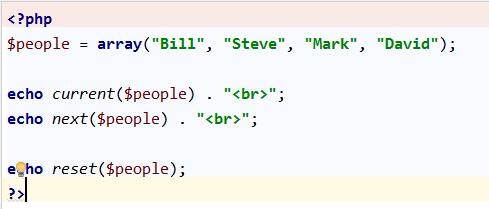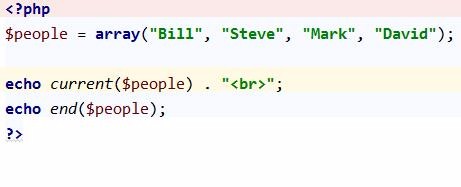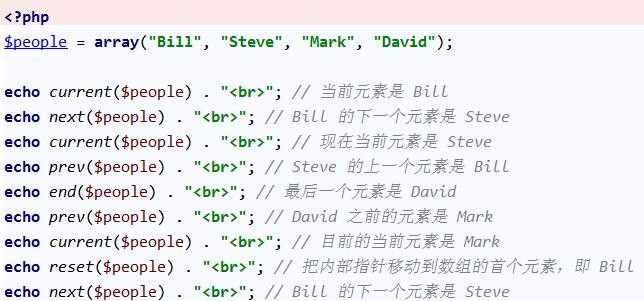
The current() function in php returns the current element (unit) in the array. Each array has an internal pointer pointing to its "current" unit, which initially points to the first unit inserted into the array. If we execute current once, the internal pointer will point to the next unit, and we can use current to get the value of the current unit in the array. This article collects several articles on the usage of PHP's array operation function current(). I hope it will be helpful to everyone's understanding of array operations. 1. php array function current() definition and usage The current() function in php returns the current element (unit) in the array. If the current element is empty or the current element has no value, it returns FALSE. Each array has an internal pointer pointing to its "current" element, which initially points to the first element inserted into the array. This function does not move the internal pointer of the array. If you need to move the pointer, you need to cooperate with other functions. Let’s take a look. 2. Detailed explanation of php end() function and current() function usage examples in php end
1. Recommended 10 articles about current()

Introduction: The current() function in PHP returns the current element (unit) in the array. Each array has an internal pointer. Points to its "current" unit, initially pointing to the first unit inserted into the array. If we execute current once, the internal pointer will point to the next unit, and we can use current to get the value of the current unit in the array. This article collects several articles on the usage of PHP's array operation function current(). I hope it will be helpful to everyone's understanding of array operations. 1.php array function current(...
2. 10 recommended articles about pointer pointing

Introduction: The current() function in PHP returns the current element (unit) in the array. Each array has an internal pointer pointing to its "current" The unit initially points to the first unit inserted into the array. If we execute current once, the internal pointer will point to the next unit. We can use current to get the value of the current unit in the array. This article collects several articles about. The usage of php array function current(), I hope it will be helpful for everyone to understand array operations. 1.php array function current(...
3. About php current. Recommended 10 articles

## Introduction: The current() function in PHP returns the current element in the array (unit), each array has an internal pointer pointing to its "current" unit, which initially points to the first unit inserted into the array. If we execute current once, the internal pointer will point to the next unit, we You can use current to get the value of the current unit in the array. This article collects several articles on the usage of the PHP array function current(). I hope it will be helpful to everyone's understanding of the array operation. 1. PHP array function current(...
4. 10 recommended articles about array operations

##5.
10 recommended articles about the php current() functionIntroduction: This article mainly introduces the relevant information about the detailed explanation of the java ThreadPoolExecutor concurrent call instance. Friends who need it can refer to the detailed overview of the java ThreadPoolExecutor concurrent call instance. Usually in order to provide the processing speed of the task, some concurrency models will be used. , invokeAll in ThreadPoolExecutor is one. Code package test.current;import java.ut... 6. php returns the elements in the array current() function usage summary Introduction: The current() function in PHP returns the current element (unit) in the array, and there is one in each array The internal pointer points to its "current" unit, initially pointing to the first unit inserted into the array. If we execute current once, the internal pointer will point to the next unit. We can use current to get the current unit in the array. value. This article collects several articles on the usage of PHP's array operation function current(). I hope it will be helpful to everyone's understanding of array operations. Introduction: The current() function in PHP returns the current element (unit, which is the first element of the array) in the array. The next() function points the internal pointer to the next element in the array. element and output the value of the element. The reset() function points the internal pointer to the first element in the array and outputs the value of the element. This article mainly introduces the usage of current, next and reset functions in PHP. The example form details the specific usage of the functions current, next and reset for array operations in PHP. It has certain reference value for in-depth understanding of the usage of arrays. I hope it will be helpful to everyone's understanding of arrays 8. Detailed explanation of php end() function and current() function usage examples Introduction: The end() function in php points the internal pointer of the array to the last element and returns the value of the element, while the current() function returns the current element (unit) in the array, which is the first element of the array. One of the two functions returns the first element of the array, and the other returns the last element of the array. Let’s take a look at the usage of these two functions. 9. php Array Definition and usage of function current() #Introduction: The current() function in php returns the Current element (unit), if the current element is empty or the current element has no value, it returns FALSE. Each array has an internal pointer pointing to its "current" element, which initially points to the first element inserted into the array. This function does not move the internal pointer of the array. If you need to move the pointer, let's take a look. php array php array function. Next of the sequence - moves the internal pointer of the array to the position of the next element, and returns the element value [Related Q&A recommendations]: PHP SplFileObject’s fgets( ) and fgetcsv() fails to return the correct row after seek().python2.7 - Is there an equivalent expression for async for in python 2.7? node.js - What does the first parameter of the Call function of the V8 engine Function class mean? 



The above is the detailed content of 10 recommended content for current(). For more information, please follow other related articles on the PHP Chinese website!




